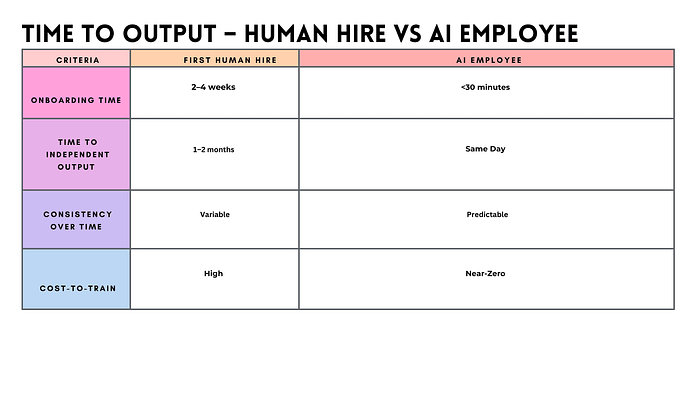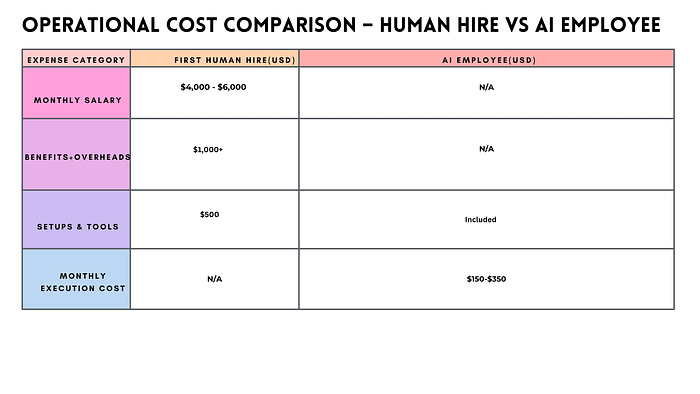Startups run lean. Every decision, especially the first hire, can feel like a gamble. Founders often wait until they’re stretched thin, juggling product, marketing, ops, and customer support before they consider bringing someone on. But hiring early isn’t just costly, it can be operationally heavy and mentally draining.
Now play this out: your first hire never asks for a raise, never misses a deadline, and runs on logic, not mood. Not a contractor. Not a tool with fancy features. A system that learns, acts, and delivers outcomes you can measure.
This isn’t about replacing people. It’s about designing your earliest operations with precision and scale, before culture, payroll, and headcount enter the picture.
Why Hiring Feels Broken for Early-Stage Teams
The first hire sets the tone. But the process is usually flawed from the start. It takes time, often 4 to 6 weeks on average, to identify, vet, and onboard the right candidate. Add training, feedback loops, and performance management, and you’re looking at months before true value emerges.
According to SHRM, the average cost-per-hire in 2023 is over $4,700. And that’s without factoring in indirect costs, opportunity lost, delayed execution, and the mental bandwidth it consumes.
Worse, a wrong hire is expensive. A 2023 LinkedIn study found that 34% of early startup hires don’t last beyond the first year. Early-stage founders are then forced to start from scratch, again.
So what happens when execution doesn’t need to be tied to headcount?
With the rise of AI employees, we’re entering a new phase, one where founders can shift from people-first operations to performance-first architecture. It’s not a replacement strategy. It’s a precision one.
What an AI Employee Actually Looks Like as a “First Hire”
An AI employee isn’t a tool that waits for you to click. It’s a smart agent that works off objectives, not instructions.
For instance:
- A lead-gen agent that reviews every inbound form, qualifies leads based on set parameters (industry, potential LTV, urgency), and kicks off the appropriate nurture or outreach track.
- A finance agent who runs bi-weekly forecasts, monitors anomalies, and adjusts vendor or marketing spend proactively based on real-time liquidity.
- A support agent who triages helpdesk tickets, solves common queries autonomously, and escalates only edge cases with context-rich summaries.
Unlike assistants that require micromanagement, these AI agents understand intent. They operate with modular logic, adjusting their behaviour as conditions shift, without a human reconfiguring anything.
You’re not replacing a team. You’re laying a smarter operational foundation, where actions happen without nudging.

Source: SHRM 2023, internal benchmarking across AI-first startups
The Difference Between Replacing Work vs Replacing Humans
A common fear is that AI kills teams. That’s rarely the case in high-functioning startups. Instead, it clears the mental clutter that prevents teams from doing meaningful work.
People don’t join startups to monitor forms, chase invoices, or pull weekly reports. They join to solve, build, and collaborate. But when repetitive tasks take over, even top performers burn out.
AI employees handle the predictable so your actual hires can handle the strategic.
They don’t ask for seats at the table. They just keep the table clean.
ALSO SEE : THE HIDDEN COST OF EARLY HIRING( WHY SMART FOUNDERS ARE GOING AI-FIRST)
How Founders Are Quietly Skipping Their First Hire — And Moving Faster
Smart operators are bypassing the old “hire-to-scale” mindset. They’re deploying AI agents to stabilize the backend, build early traction, and collect insights. Then, once the business model firms up, they hire humans to grow the business not patch it.
Let’s break that down:
- DTC brand: One founder used an AI agent to manage inventory reorders, customer feedback analysis, and logistics notifications. No ops hire needed.
- Agency startup: Used AI employees to qualify leads, auto-generate proposals, and handle onboarding sequences. No client success manager yet.
- Solo course creator: Deployed a content agent to repurpose videos into blog posts, tweets, and newsletters, saving 15 hours weekly.
These aren’t hacks. They’re strategic setups that scale early without adding headcount.

Source: U.S. Small Business Administration, Internal Pilot Studies
This Isn’t a Shortcut. It’s a Strategy.
Shortcuts cut corners. Strategies create leverage.
Founders who deploy AI employees as their operational core aren’t just saving money they’re designing companies that learn faster, adapt quicker, and stay lean longer.
These systems aren’t meant to replace great hires. They delay the need for them. They help founders figure out what roles to truly invest in and which functions never needed a human in the first place.
The result? Better hires. Clearer processes. Less waste.
Join the Founders Rewriting the Rulebook
Hiring used to be the first big step. Today, it’s often the second, or third.
Founders across industries are rewriting what their first 18 months look like by building a layer of AI employees that execute reliably, scale flexibly, and never need a manager.
Cleverfolks AI Employees are designed for that future, outcome-focused, logic-driven, and ready to work on day one.
